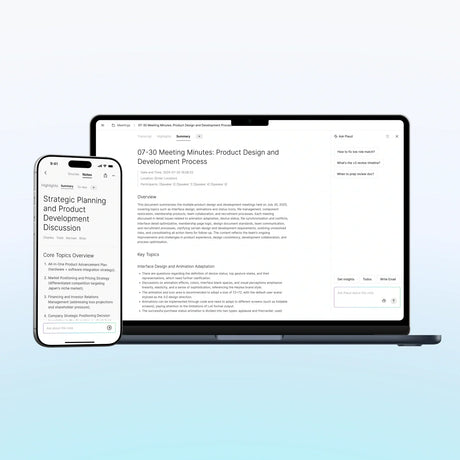Teachers are incredible people. What they do for our kids — for our future — is nothing short of remarkable. You signed up to be a part of this, to make a genuine difference in the lives of others. But somehow, somewhere along the way, things changed. Yes, your work is rewarding, but still, you end each day nothing short of exhausted.
Even more than tired, you've begun to withdraw. You're feeling anxious, like you might be forced to leave a job you love.
How do you overcome teacher burnout? This guide gives you some practical strategies to spot it early on and make changes that lighten your load.
What causes teacher burnout?
You love your job. Not every part of it, sure — but the heart of it. Being there when something clicks. Watching a student try, mess up, and try again. Seeing them start to believe they can do more than they thought. That still matters. That's why you stay.
But it's also just... a lot. You're juggling planning, behavior, emails, meetings, tech issues, the kid who's not okay, and the one who just needs more of you than you have to give. You're "on" all the time — even when you're tired. And honestly, most days, you're tired.
Burnout doesn't show up like a broken bone. It builds in the background. It's the kind of tired that lingers. The disconnection that sneaks in when you still care, but feel numb. The part of you that starts to slip — your patience, your focus, your energy — even when you're trying.
That's not a flaw. It's not you being weak. It's what happens when you're carrying too much, for too long, without enough space to breathe.
What are the teacher burnout symptoms?
Teacher burnout is something that gradually builds over time. It lasts longer than a rough week and doesn't improve with a short break.
Watch for symptoms that continue for several weeks or more. These might include:
- You feel tired when the day starts. Routine tasks use more energy than they used to.
- You still care about students, but it's harder to stay connected. You feel distant or unresponsive.
- You overlook details and make little mistakes. You spend more time planning. Problems take longer to solve.
- You avoid conversations. You stop offering input.
You start to wonder if any of it matters. You're putting in the time, but it feels like it's not reaching anyone. Not your students, not your admin, not even you.
When burnout drags on, you stop sleeping well. You wake up tired. You can't focus like you used to. Little things feel harder than they should. And slowly, it starts to bleed into how you teach and how you respond.
Teacher burnout statistics
Burnout is a persistent issue in the teaching profession. Many teachers experience it early in their careers.
Each year, about 12 percent of teachers leave the field. New teachers are more likely to leave than those with experience. Those who start without structured preparation are 2.5 times more likely to quit after their first year.
In a survey, 90 percent of teachers said burnout is a serious concern. Sixty-seven percent called it very serious. These responses reflect sustained pressure, not isolated challenges.
How to avoid teacher burnout?
Here's how teachers can avoid burnout.

Apply a "return on investment (ROI)" mindset to classroom strategies
Not every great-looking idea is worth your time. Before adding a new classroom tool or method, pause. Think about what it will actually cost you in time, focus, and energy.
Start by questioning the setup. How long will it take to introduce this to students? Will you need to reteach it every week? Does it require daily upkeep or new materials?
You can track this in real time. When an idea pops up — maybe from a coworker, a blog, or social media — record your reaction. Clip your Plaud NotePin to your shirt or bag, press once, and speak it out loud. For example: "New blurt jar idea — seems fun, but needs 5 minutes to explain, 3 minutes daily to manage." Later, search that clip using AI in the app by keyword and review it before committing.
Good news for educators gearing up for the new term: from 12:00 AM PDT on August 5th through 11:59 PM PDT on August 7th, 2025, enjoy exclusive Back-to-School savings on Plaud.ai. Save 10 % on any Plaud Note or Plaud NotePin, get 10 % off when you purchase two of the same AI plan, and take an instant $16 off any hardware + AI bundle. Plus, if you signed up for Early Access by August 4th, you’ll automatically receive a bonus 600 minutes of transcription with your hardware purchase—no code needed, discount applied at checkout.

This lets you compare options before overcommitting. Ask if the time you'll spend matches the real value it adds. If it adds stress or pulls focus away from what matters most, skip it. A simple system that runs well beats a complex one that drains you.
Set clear boundaries for work hours
Working well beyond your scheduled hours doesn't lead to better outcomes. It often reduces your capacity to stay focused over time.
Start by setting a clear end to your workday. If your contract outlines 8 hours, keep your workload close to that. Long-term overwork often leads to burnout, not better results.
Build specific boundaries that support your time limits. For example:
- Set a routine for stopping work each afternoon.
- Avoid checking email during off-hours.
- Decline optional tasks that extend your day.
- Track unpaid work.
Want to know how to avoid teacher burnout if you're working part-time? Avoid patterns that match a full-time load. If you're full-time, look for routines that extend your day without improving outcomes.
Leaving on time twice a week can improve your balance. This change doesn't require a full schedule reset. It begins by treating your time as a limited resource.
Boundaries protect your commitment. When you use your off-hours to rest and reset, you return with more clarity and stability. Over time, that consistency supports better teaching and a more sustainable workload.
Rethink and simplify routines and procedures
Routine does not always mean efficient. Many classroom systems require more time and energy than they return.
Look at how your day actually runs. That includes behavior systems, grading routines, transitions, and the way you handle communication. Don't skip the small stuff either. Things like sharpening pencils, handing out papers, or sorting folders add up.
For each task, ask yourself how long it takes and how much energy it costs. Some things take more out of you than they give back, and those are worth rethinking.
Then look for practical replacements. You might switch from paper portfolios to digital updates, or replace a multi-step reward system with verbal reminders. You could also combine tasks that repeat or trim routines that take too long to explain. Small changes like these often free up time without lowering the quality of instruction.
It's okay to say no. Not every idea needs to make it into your classroom. Just because it works for someone else doesn't mean it works for you or your students.
Some routines look great on paper but take more energy than they're worth. If something's taking time from your planning or leaving you more stressed than supported, it's not doing its job.
Adjust communication expectations (internal & external)
You don't need to write perfect emails or answer every message right away. Communication matters. But trying to write the best possible email every time will burn you out fast.
You don't need an A+ response. You need something clear and respectful that gets the point across. A B-minus is more than enough. Parents usually just want to know what's going on. They don't need long explanations.
Say what you need to say, then send it. If a tool can make it quicker, use it. If an app can attach a rubric or send automatic updates, use it. The goal is to keep families informed without doubling your workload.
When you're in the middle of a parent call or student check-in, clip on your Plaud NotePin and press record. Say what matters out loud — key questions, follow-ups, next steps. Later, search by keyword, then copy what you need into an email or platform update. Plaud makes the voice memo-to-text process effortless.
Finally, set limits for when you'll respond. You're not expected to check email during dinner or reply on Sunday night. Model the boundaries you'd want respected. A next-day reply is still professional, and it keeps your time your own.
Conduct regular evaluations
What worked at the start of the year might not be working now. That's normal. Things change. Your class changes. You change, too.
Use natural checkpoints to pause and look at your systems. That might be the end of a term, after a long break, or just a week that felt harder than it should have. Ask yourself what's still working, what's getting in the way, and what feels too much.
Use your Plaud NotePin after class while everything's still fresh. Press once and say what you noticed. Maybe it's "Morning routine takes too long" or "This grading shortcut saved me time." Later, when you're ready to make changes, you won't be guessing.
Let go of what no longer fits. Just because something worked in September doesn't mean it still makes sense now. That's not quitting. That's paying attention, and it helps to keep the job from taking more than it gives.
Create space to keep going
Burnout doesn't mean you chose the wrong work. It usually means the conditions around that work need adjustment. Now that you know how to prevent teacher burnout, you can start small. Change one routine. Set one boundary. Leave on time one more day each week.
You're here because you care. That's what makes this worth protecting.
FAQ
What is teacher burnout?
Teacher burnout is when the job wears you down to the point where showing up feels almost impossible. You're tired all the time, small things feel big, and the work and kids start to blur together.
How do you overcome teacher burnout?
To overcome teacher burnout, you have to be honest about what's too much. Cut what doesn't need to be there. Leave earlier when you can. Say no more often.
What are the risks of teacher burnout?
Burnout can take a real toll. You might stop sleeping well or get sick more often. It wears you down in ways you don't always see until you're already deep in it. And it's hard to climb out.






